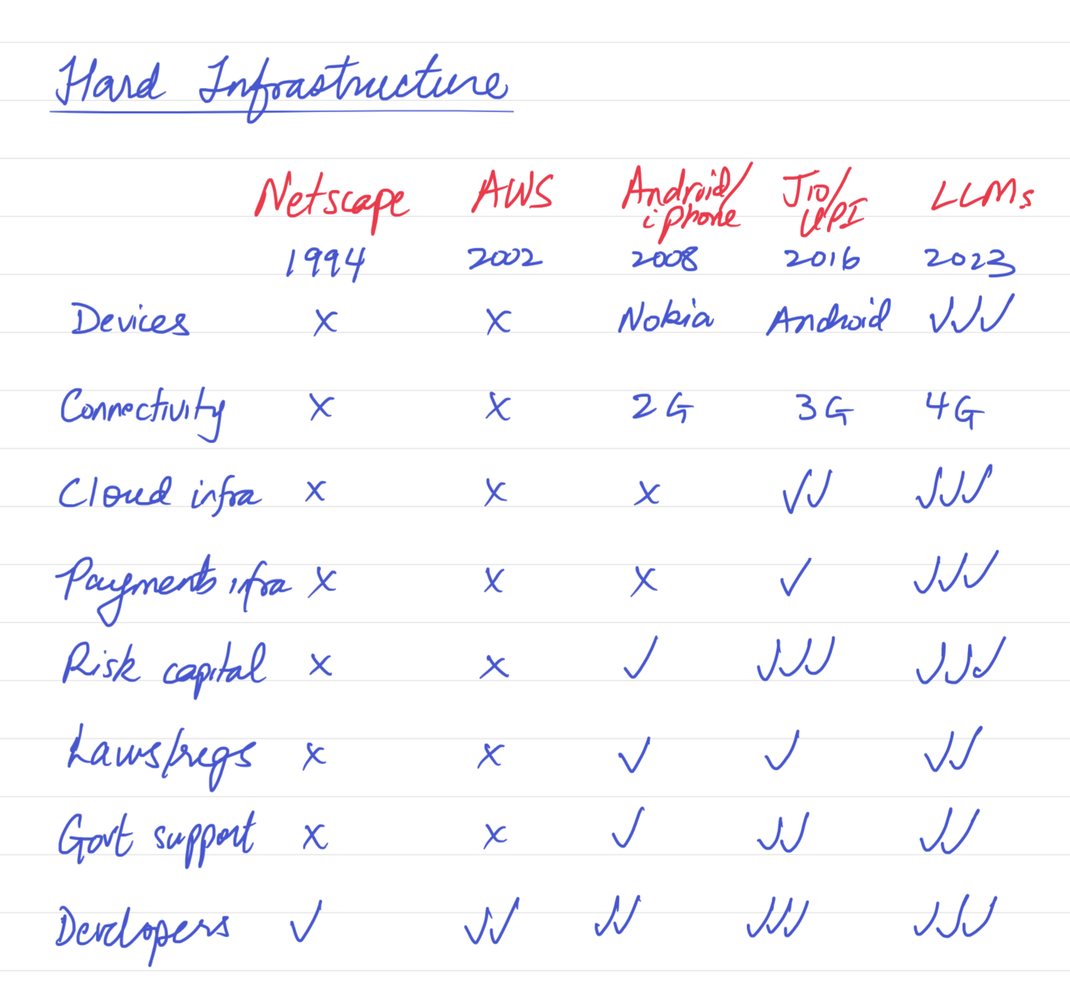Looking back at history, we can see the monumental shifts that have shaped the tech landscape globally. Netscape (1994), PayPal (1996), AWS (2002), Android (2008), 4G (2010), and the India Stack (incl UPI 2016). One can argue that when these technologies got launched elsewhere in the world, India was not ready to launch thousands of startups. Basic hard infrastructure was missing from the ecosystem. Soft infrastructure like confidence, playbooks, role models, widespread awareness of the Internet was lagging further behind hard infrastructure.
Now, in 2023, when AI is bringing the next big shift, India is ready. We have laid down the foundation, brick by brick, and we have built something incredible. We have the cloud infrastructure, the talented developers, the necessary capital, we have the hard infrastruture we need.

We also have the soft infrastructure — the guiding role models, the playbooks to launch and scale, and the invaluable lessons from both failures and successes. We have the knowledge. We have the right to win.

I think,
- we are not missing anything now, in 2023, to be able to compete effectively in AI.
- there is no reason to have the lag effect we have observed in the past.
- there are a 1000 reasons why India startups can be right on the cutting edge of AI innovation.
***
So what should we go win? Not only with existing companies that can redefine their products using AI but a slew of new companies built AI-first ground-up. We need to do it our own way, rather than following or copying what’s going on elsewhere in the world, in a way that serves India well and also is differentiated.
The opportunities are multi-fold.
- WRT foundational models or LLMs, I do think geopolitics will cause winners to rise in different geographies. We are already seeing many come from the US, some from China, and some from Europe. I think India should have its own… it’ll require a whole different level of capital and innovation — perhaps there is a different way India can go here with a public goods approach, like UPI, Aadhar etc. Or otherwise some of our larger tech companies may choose to go after this with private models.
- WRT infrastructure, we can build infrastructure/dev tools for the world, as we have shown through companies like Postman, Druva, Browserstack, and Acceldata. India has 9 million developers and they need tooling and infra much like developers anywhere else in LLMOps, data management, security, data creation etc.
- WRT business applications, we have a strong opportunity to go after markets in India, the US, and global markets. We can go after existing horizontal markets with new workflows and applications, like we have done in the past with customer support, ITSM, sales automation, human capital management, finance, marketing. We can go after verticals with bespoke B2B solutions, like we have done in the past in healthcare IT, BPO automation, retail, financial services, and even the SMB/informal economy etc. New verticals are opening up with AI like legal, marketing and content.
- WRT consumer applications, we have one of the largest consumer bases in the world right here at home. We can build a whole set of consumers experiences whether in education or media or gaming or financial services to open up new segments of the population or provide services profitably, including even at lower price points. The opportunity is with new consumer experiences and breaking constraints that have held back developers on previous platforms.
The potential to create and capture value here is immense and the opportunity is ours to lose. This time, it’s different!
This article was originally published on LinkedIn.

























